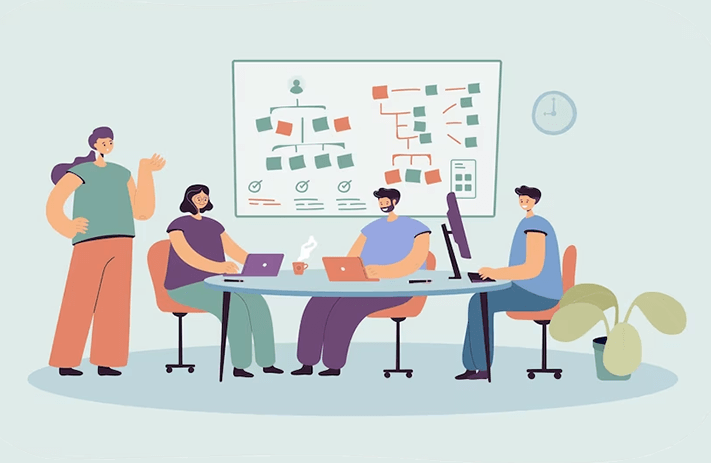
Click the button to start reading
The Best Practices, Tools & Softwares to Simplify Change in Your Organization
If you’ve spent any time as a project manager, you’ve experienced plenty of resistance to change. Maybe the requirements change midway through a project, and then key players throw up their hands and quit in fits of frustration. Or a project’s timeline gets cut short and the entire team is thrown in a tizzy.
Whether the resistance is active, passive or intellectual, deflecting it and successfully implementing a change is one of the most difficult challenges a project manager faces.
And here’s the kicker. Change is not only difficult, it’s also constant. Change is necessary for growth and the overall success of the business. Shifts in the demographics of a workforce over the years demands changes in the workplace culture. In order to recruit top talent, a company may need to change its onboarding and offboarding processes.
Success primarily depends on how the change is implemented. A poor execution looks like an elaborate house of cards. For a short time after the change, things churn along fine, but then a tiny tremor or gust of wind collapses everything into a chaotic state of dysfunction. A proper rollout, on the other hand, is more like the caterpillar that molts each spring and transforms into a beautiful butterfly, never to return to its original state. It’s completely integrated into the company’s culture and systems.
Whether you’re moving to a new office, going digital, implementing a new software, or doing something else, making a successful change requires a good process and the right software and tools.
If in the past you’ve made huge attempts to overhaul a system only to arrive back at square one, then you’re probably ready to approach change proactively. This post is going to cover some popular methods to implement change and the tools and softwares that assist with a smooth rollout.

3 Popular Models to Manage Change
When a new process or system is announced at an all-hands meeting, people often feel like they’ve been thrown a curve ball. Even when the change offers tangible benefits, the initial reaction is to dodge and avert it. Most of us lean in on the familiar, and anything that upsets our routine quickly fizzles and falls flat.
And so a strategy is helpful to overcome these growing pains and to integrate a change into an organization. Many methods have been developed over the years. Identifying the right approach can be trial and error, and one of the best practices for managing change is to become familiar with all the methods out there. Here are three popular approaches to managing change, and a brief explanation of each.
1. Kotter Change Model
Over the span of his career, Harvard Business School professor John Kotter established himself as a thought leader in organizational change. In 1996 he published Leading Change, which outlines eight steps for an organization to follow when implementing a change. The success of his method over the ensuing decades has made it a popular go-to for organizational transformations and large-scale change.
The method focuses on communication and employee buy-in. The specificity of his eight steps make the method a useful tool for anyone who’s managing change for the first time. The following is a summary of his steps.
1. Create a Sense of Urgency
The first step establishes a strong “why” behind the change. In the instance of an office relocation, this may mean demonstrating how the current building shows signs of decay. With a digital transformation, it may mean showing how the competition is using new automations, and an upgrade is necessary to stay in the game.
Urgency is created by communicating the stakes at play, and indicating how individuals will be impacted by a failure to change. When people understand how a situation affects them personally, they’re more likely to get on board. A persuasive presentation is backed up by statistics and expertise.
2. Form a Powerful Coalition
Even if someone is the CEO, he or she cannot single-handedly implement a change. For a rollout to succeed, as much as 75% of the management needs to support it.
The Diffusion of Innovation theory is helpful to consider when establishing a change coalition. This theory states that the early adopters to a new idea or process represent fewer than 15% of the organization. When these initial adopters are key influencers, it’s easier for the idea to gain momentum and garner more proteges. A powerful, influential coalition includes people in senior levels of leadership, those with technical expertise, as well as individuals who possess social clout within the workforce. An extremely popular receptionist, for example, may be key to getting the skeptics on board.
3. Create a Vision for the Change
“Change,” generally speaking, is a dirty word. At the onset, people are inclined to reject it. Framing the change as an aspirational vision creates momentum and generates enthusiasm.
Forming a clear, strong vision starts by soliciting contributions, ideas, and feedback from key stakeholders. Themes, values and an overall goal emerges from these discussions, which provides a blueprint for the vision.
4. Communicate the Vision
Developing a strong vision is only half the battle. Communicating it to the rest of the organization is the essential next step. A powerful slogan can capture the essence of the change and communicate its benefit to the rest of the organization. This can be something simple like “let’s create opportunities” or “make a difference today.” Things like swag disseminates the vision throughout the workforce, and propels everyone into the desired future state.
A successful message incorporates an element of “WIFM,” or “what’s in it for me.” Rather than simply stating benefits in the abstract, the vision outlines the specific ways that a change impacts individuals. Additionally, it’s important to consider those persons and departments who are most impacted by a change, and to concentrate the communication efforts to these individuals and groups.
5. Remove Obstacles
Even when a clear vision has been established and communicated, there’s usually plenty of roadblocks and obstacles. Maybe the change is impeded by a strong contingent of saboteurs, or it’s facing passive or intellectual resistance.
The first step is to identify the obstacles, and then to apply a remedy. Intellectual resistance is the easiest. Usually it can be fixed with education. Once someone understands how to use a new tool, for example, they are more inclined to cooperate with a change. Saboteurs can be converted through 1:1 dialogue. Passive resistance often is the hardest to identify. It’s expressed when people show up at a meeting but don’t participate, or when a team produces only the baseline requirements. One way to remedy passive change is to incentivize participation and going the extra mile.
6. Create Quick Winds
Once the change has been rolled out and obstacles are removed, it needs reinforcement. This allows the change to become integrated into the organization. Kotter recommends reinforcing change by setting short term, achievable goals. With each goal achieved, the team feels a sense of accomplishment. This propels everyone to proceed through the difficult adjustment stages.
7. Build on Change
A successful change needs strong roots, and this takes time. Integrating a change into an organization means periodically appraising the situation, weeding out impediments and fertilizing the change with new goals and benchmarks.
8. Anchor the Change in Organizational Culture
An organization’s culture is expressed in all of the aspects of the workplace, both large and small. It’s reflected in employee well-being, leadership styles, and everyday communications. A successful change becomes integrated into all of these areas. It’s mentioned in meetings, and incorporated into the company mission statement as well.
2. ADKAR Change Model
ADKAR is an acronym that stands for Awareness, Desire, Knowledge, Ability and Reinforcement. This method for change management was developed by Prosci, a company founded in the 1990s that specializes in individual and institutional change.
The ADKAR approach has proven successful in both complex, large-scale, changes and small changes alike. The secret to this method is that it orients an organization around the goals of the change. Its individual approach to change fosters widespread buy-in. Let’s summarize each of the five components to ADKAR.
1. Awareness
The first step to the ADKAR model is to explain the “why” behind the change. This includes outlining the stakes at play, as well as the benefits to making a big change.
Without this awareness, a team may feel they’re being forced to jump through a whole lot of hoops. Awareness mitigates some of the initial frustration and resistance by providing meaning behind the change. By taking the time to transparently explain the “why,” the leadership cultivates compliance within the team.
2. Desire
As previously mentioned, when people hear “change” they synonymously hear “hard.” Creating desire for a change is one of the most difficult yet essential steps in the ADKAR model.
In part, cultivating this desire means outlining WIFM for everyone who is impacted by the change. The impact varies depending on the department and the individual, and so successfully fostering desire means crafting messages tailored to separate teams and persons.
3. Knowledge
This third step is so obvious that oftentimes a change practitioner jumps to it right away. “Knowledge” means to disseminate the information that’s needed to implement the change. If the company is changing to a new software system, for example, it trains teams in how to use the new software, and explains how it differs from the old system.
While this step is critical, it is most effective when everyone has already been primed for the change. People are more willing to take in new information when they have an interest in it. And so this step is the most fruitful when it is preceded by desire and awareness.
4. Ability
This is the stage where the rubber meets the road. Whereas the previous step instills information, at this fourth stage an organization develops the ability to implement the change.
It usually takes a few weeks to become proficient with new processes and tools. In an agile transformation, for example, everyone initially struggles to adapt to a new method of project management and execution. This stage usually involves some hiccups and backsliding as everyone transitions and adjusts. An effective leader is patient and monitors the situation closely.
5. Reinforcement
This final stage repeats the previous four steps, in a sense. It reinforces awareness and desire, through highlighting milestones and big wins. It identifies learning gaps, and fills them with additional training. This continual reinforcement allows the change to stick.
3. Lewin Change Model
This change model was developed at the beginning of the 20th Century by the psychologist Kurt Lewin. He applied his model to societal change, individual transformations and organizational change. Its three simple steps make the process easy to understand, and it has proven successful in a variety of contexts.
1. Unfreeze
This first step lays the groundwork. Unfreezing means looking at all of the details of the change and uprooting it from the current system. First and foremost, this first stage identifies the need for change, and makes sure key stakeholders support it. This stage also entails looking at all of the risks associated with the change, as well as the anticipated resistance. It then establishes a plan to mitigate both.
2. Change
This second step is the practical component to implementing the change. This may be moving an office across town, rolling out the new software, or transforming a company to agile. During this second stage, leadership closely monitors the rollout, and reinforces the vision and reasons for the change with ongoing communication. A strong narrative explaining the reason for the change helps to dispel resistance.
3. Refreeze
This final step cements the change within the organization. It does this by calling out successful individuals, celebrating success, and developing processes that embed the change into the culture.
And this summarizes three models for change. While these methods cover many of the same points, each has a unique spin on change management. Determining the right method for you depends on the nature of the change you’re undertaking. Sometimes, the solution is to pick and choose between various methods and develop a custom-built strategy tailored to your situation.

6 Change Management Tools
Whatever change model you choose, the rollout takes some time, and it’s necessary to complete one stage before continuing onto the next. Here are some tools and techniques to use at various stages that help to speed up the process.
1. SWOT Analysis
A SWOT analysis is a powerful exercise to complete with key stakeholders at the beginning stages of a big change. A thorough understanding of the strengths, weaknesses, opportunities and threats posed by a change serves a variety of functions. Knowing all of the opportunities for the change lays the groundwork for developing the vision. Understanding the threats helps to establish a sense of urgency. Outlining the weaknesses can identify those individuals who are most impacted by the change.
In short, understanding the ins and outs of a big change helps to put a risk management plan in place. It’s also much easier to generate the motivation that’s necessary for implementing the change.
2. Pip Decks Story Cards
Communication tools such as webinars, interactive white boards, meetings and emails all help to relay that a big change is motion. But in order to bring about the momentum shift necessary to implement the change, a compelling narrative must be woven into all these messages.
Pip Decks is a popular tool used by organizations for turning dry statistics into a rich, enticing story. Its easy-to-use approach draws on archetypal story patterns, including the hero’s quest and the rags to riches story. Its interactive system allows users to hone in on specific areas of storytelling, whether it’s concept development, structure, or character development.
With a tool like Pip Decks, you won’t just be announcing the change; you’ll be captivating the team’s imagination and getting them to understand the vision and the benefits of the desired future state.
Pip Decks is available for $200, which may seem like a hefty fee, but really it’s a small price to pay for the ease with which you’ll be able to pitch your story to a team. (The digital cards cost $100.)
3. A Change Practitioner
It’s common to look at change as just one more item on the work break down structure that needs to be ticked off, alongside a litany of other tasks. But there’s a danger in approaching change so superficially. The fact is, a successful transformation requires careful attention and focus.
A change practitioner is someone who’s earned his or her stripes in change management. Maybe she’s received a certification from an organization like Prosci, and has successfully implemented changes in the past. The role of change practitioner requires skills such as flexibility, communication, leadership, and business acumen. It’s also necessary for the practitioner to have fully bought into the reason for the change.
Hiring a change practitioner or assigning a current employee to this role demonstrates a dedication to the transformation. It gives the rollout the TLC it deserves.
4. Kubler-Ross Model
The Kubler-Ross Model is a popular model that was introduced by the Swedish psychologist Elizabeth Kubler-Ross in her 1969 book, On Death and Dying. While it traditionally described the five emotional stages we go through after the loss of a loved one, the model more broadly describes the seven emotional stages we experience during any difficult change or loss. According to Kubler-Ross, these sequential stages include shock, denial, frustration, depression, experiment, decision and integration.
Being mindful of a team’s location along this emotional sequence makes it possible to apply a proper remedy and move the team smoothly to the next stage. An adept change practitioner can guide a team through the initial stage of shock, to the experimental stage where they start to engage with the new changes, all the way to integration where the change is fully incorporated into the day to day.
5. Swag
Vision and communication are both central to realizing a big change. And swag can play a powerful role in diffusing this vision to the workforce.
An aspirational slogan like “Let’s make a difference” instills enthusiasm. When this vision is distributed onto water bottles, pens, and t-shirts, it disseminates the message and helps individuals appreciate that the changes in their workday are part of a larger initiative.
The task of managing swag usually falls to the change practitioner. It includes things like finding an aspirational message that captures the essence of the change, as well as having a system for distributing the swag. One effective method is to award matching hoodies or jackets to the teams who successfully meet milestones and adapt to the change.
6. A Party
When a change is framed like a celebration, it drives home the benefits and opportunities the change promises to bring about. There’s nothing like a festive party to convert the saboteurs, soften the mules and generate enthusiasm for a new rollout. This positive emphasis creates an exploratory attitude and genuine interest in the endeavor.
This summarizes a few tools and techniques to use when rolling out a change. When combined with a strong change model, they lubricate a change and move things along smoothly.

4 Change Management Softwares
A big change or transformation impacts processes, company culture, and information technology. It involves risk and inventory management as well. And the process usually takes a good amount of time.
This means that a change practitioner always has a lot of balls in the air. A change management software can serve as a great administrative assistant in the process. It attends to all these ripple effects and organizes things through every stage of the change. It eliminates hiccups and backsliding, and allows the practitioner to successfully integrate change.
There are many softwares that assist with change management. Selecting the right one means identifying those features necessary for your transition. This includes things like communication tools, third party applications, automations, and compliance management.
Let’s go over four of the top softwares and summarize the benefits of each.
1. Proxima from Prosci
Prosci is a business founded by Jeff Hiatt in the 1990s, around the time when change management became recognized as a professional discipline. The company has become a leader in change management, and propagates the previously discussed change model, ADKAR.
Proxima is the software that Prosci offers to guide an organization through each stage in the ADKAR model (awareness, desire, knowledge, ability and reinforcement). This flexible software adapts and scales based on the size and needs of an organization. It includes an app with a calendar that tracks milestones, individual performance and organizational performance. An organization accesses these tools by earning a Prosci certification.
2. Praxie
Founded by several Silicon Valley start-up junkies, Praxie is a treasure trove of resources for a variety of disciplines, including change management, project management, human resources, and strategy.
Its change management resources include templates that complement a variety of change models. It provides user acceptance tests for evaluating the progress of a change, and process management applications as well.
Praxie offers four plans. This includes a free plan for individuals, as well as pro, premium and enterprise plans with yearly and monthly billing options.
3. 360 Factors
When rolling out a change, it’s easy to become fixated on the internal buzz, and less focused on the impacts outside the organization. However, large scale changes can have a huge impact on compliance and regulations.
This is where 360 factors come in. This software monitors the rollout of a change, and oversees the risk and impact on security and compliance. With this software, you won’t have to worry about violating any government regulations due to negligence. It has you covered.
4. How Space
Maintaining fluid communication is one of the biggest challenges to change management in remote teams. How Space is a platform that provides a central hub for teams to gather and communicate with one another.
With this tool, it’s quick and easy to gather feedback on the rollout of a change, to mitigate issues before they become problems, and to quickly move a team through the change process.
Conclusion
Organizations go through so many changes all the time. Changes include scope creep, schedule increases, and adjustments to the final deliverable. Sometimes it’s an introduction of new products, or a change in the leadership.
And in nearly every instance, change encounters resistance. Why? Because new skills are a challenge to learn. Sometimes a distrust of leadership leads to sluggishness and non-cooperation. Without proper management, any new rollout is likely to end up right back where it started.
Yet change is imperative for an organization to survive. Without change, it’s impossible to grow or adapt.
In order to implement change successfully means first of all selecting a change model to structure the process. Various tools and techniques assist as well. And with the right softwares to offer support, you’ll have all the assistance you need to successfully implement a change or transformation.
















